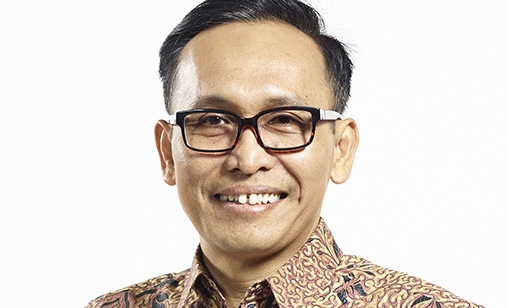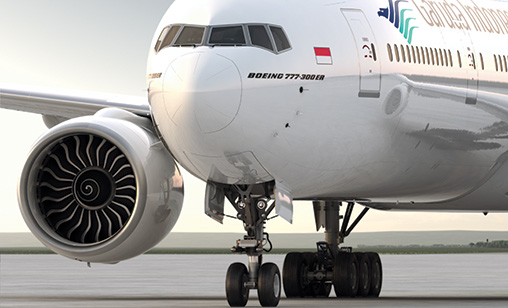News Backgrounder
Garuda Indonesia’s bottom line zealot
After guiding Garuda Indonesia back to profit in 2015, the airline’s CEO and president director, Arif Wibowo, is embarking on a fleet and network expansion to lift the carrier into the top tier of the world’s airlines.
July 1st 2016
When Arif Wibowo took charge of Garuda Indonesia in December 2014 , the carrier was about to announce a $368.9 million loss for that year. Read More » Twelve months later, his “Quick Wins” strategy returned the airline to the black, with a profit of $77.7 million.
“It was perfectly done,” he said of the plan, which reduced costs, re-structured the network and streamlined part of the fleet. “We benefited from the fuel price. At the same time, we were struggling with the depreciation of some currencies in the region, not only the Indonesian Rupiah but in other markets like Japan, Korea and elsewhere. That really dragged on the top line,” he said.
 |
| CEO and president director Garuda Indonesia, Arif Wibowo: Hopeful of flying to the U.S. in 2017 |
But the Quick Wins of 2015 are not enough for the very energetic and social media focused Wibowo. He told Orient Aviation on the sidelines of the International Air Transport Association annual general meeting in Dublin last month that he is pressing ahead with “Sky Beyond”.
The new strategy aims to add growth of between five and six per cent a year to the parent company’s businesses and integrate the operations of the Garuda group to improve the efficiency.
Its goal is to build the Garuda Indonesia group into an enterprise with an annual turnover of $10 billion, compared with $3.8 billion today, and for the airline and its subsidiary, Citilink, to be the operators of 250 airliners, 53 more aircraft than the two carriers fly now.
Wibowo said: “Now is the era when we have to be on a par with other global airlines. We have to be strong, not just domestically, but regionally and internationally.”
A critical element of the expansion strategy is a fleet renewal plan that will see A320neos for Citilink, 50 B737 MAXs for Garuda, with 30 options, and the conversion of an order for seven classic A330-300s to 14 new A330neos. Wibowo also is in discussions with Boeing and Airbus about a potential order for B787s or A350s.
“I think size really matters [when competing with leading carriers] so we have to fight with bigger capacity, but have a low-cost mindset while delivering high service,” said Wibowo, who ran the group’s low-cost carrier, Citilink, before he was promoted to the top job at Garuda.
At present, Garuda flies B777-300ERs to London and Amsterdam, as well as to Jeddah. In March, it moved its London services from Gatwick to Heathrow and offers a five times a week service. It flies to Amsterdam six times weekly.
It also has been focusing on new destinations in China, where it flies to Beijing, Shanghai and Guangzhou from Jakarta. This year it wants to link the big three Chinese cities directly with Denpasar, which is the entry airport for Indonesia’s premier resort of Bali.
But the most important breakthrough Garuda could achieve this year would be the right to fly to the U.S. Garuda suffers from the problems of an national aviation infrastructure and regulatory regime that does not meet U.S. aviation standards.
The airline cannot fly to North America because Indonesia only has a Category 2 rating from the U.S. Federal Aviation Administration (FAA).
But Wibowo told Orient Aviation in June there could be positive news coming from the FAA for Garuda. “I am hopeful it can be sorted out by the end of this year so flights to the U.S. can be considered for next year,” he said.
“If that happened, it would be part of the utilization of the B777 to the west coast cities of Los Angeles or San Francisco. The size of the market from the U.S. to Indonesia is around 400,000, but from the west coast it is around 120,000 from Los Angeles. So we could consider launching services.”
The Garuda CEO said his ultimate aim is to shape Garuda into a stable business that has sustainable profits. To do that he has identified four priorities: fleet costs, reduced overheads, a restructured route network and a concentration on revenue management.
 |
| 'In terms of traffic we have grown it at around 4%-5%, but in terms of yield it has decreased about 13%. That is very challenging. But at least we are still secure about capacity growth. I am confident we will be profitable overall this year. But we have to do that consistently' |
| Arif Wibowo Garuda Indonesia President and CEO |
“We also are strengthening our IT backbone on the commercial side. With the digital economy, e-commerce has to be improved as soon as possible. Garuda has to be very strong in high-tech and high-touch, human-to-human and be customer focused,” he said.
Another plus for the group is Garuda’s planned move to the new Terminal 3, Ultimate, at Soekarno-Hatta International Airport in Jakarta. “Ultimate” is scheduled to open at the end of the year. Garuda, its SkyTeam alliance partners and all other international airlines will be housed at the terminal, which will significantly enhance the airline’s hub status at its home airport.
Longer term, the government has said that in five years, Jakarta’s Soekarno Hatta airport will have a third runway and that it expected to have approval by then to build a fourth runway at the airport metropolis. It is forecast that transit passengers will increase from 12 million a year today to 15 million annually within a few years.
As for 2016, Wibowo is well aware that these are challenging times. “It is quite tough. We are still growing so our profit in the first quarter was quite narrow, only $1 million. This is very low.
“In terms of traffic we grew it around 4%-5%, but in terms of yield it has decreased about 13%. That is very challenging. But at least we are still secure about capacity growth. I am confident we will be profitable overall this year. But we have to do that consistently.”
| Sky Beyond at Garuda Indonesia Said Garuda Indonesia’s CEO and president, Arif Wibowo: “we are working with consultants to make sure that in the next five to 10 years and onwards Garuda will be run as a business by synergizing every company in the group. “I have to prioritize and understand which is revenue stream driven in the group and which one is the service stream. I hope by restructuring the organization we will build and, as I say, dream of becoming a $10 billion business with margins of at least 5%.” The key elements of the Garuda Indonesia Group’s Sky Beyond strategy are: * Leveraging Indonesian hospitality because it is the differentiator Garuda can offer to the market. * Building a low-cost leadership mindset at Garuda’s full-service airline and encouraging Garuda staff to do everything possible to maximize returns. * Achieving work synergies across the Garuda group, which comprises Garuda itself, Citilink, the air cargo arm, GMF (Garuda maintenance), ground handler Gapura Angkasa and Aerowisita , the group’s food, travel and hotel arm. |